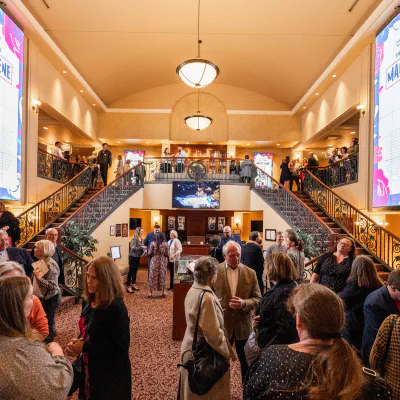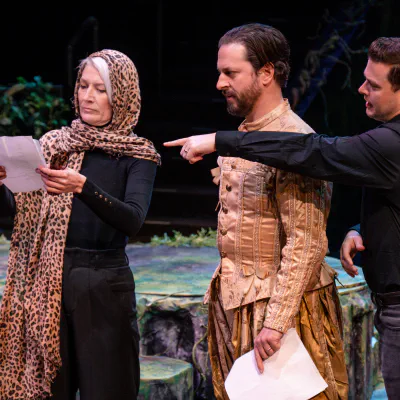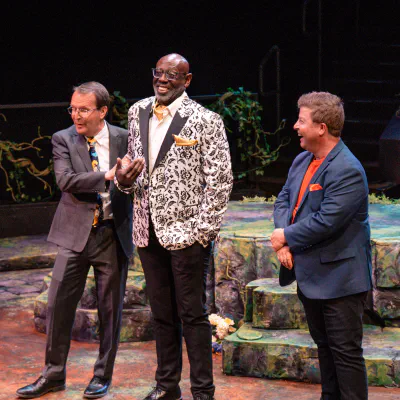News From the Festival
Paiute Tribal Youth Return to Perform at The Greenshow

In 2021 and 2022, the Paiute Tribal Youth Performers from the Paiute Indian Tribe of Utah took the stage before The Greenshow each evening. The performances consisted of dancing, flute playing, and drumming by the talented local youth.
This year, the Festival is excited to announce that the Paiute Tribal Youth Performers will have the entirety of a Greenshow to share their talent. Their show will be one of three themed shows that will rotate throughout the week––in addition to Director Britannia Howe’s English Regency Garden Party and The Hills of Appalachia.
Native Youth Coordinator Roger Clark explained that different youth performers will rotate through the summer’s performances and that there will be drumming, singing, dancing, and flute playing.
This is the first time ever that another organization outside of the Festival has produced an entire Greenshow, and Clark is excited about the opportunity.
“It will give us the opportunity to better build awareness of the indigenous people of this area, with the focus on the Paiute Indian Tribe,” Clark said. “We are excited to share our youth’s talents.”
Our Festival patrons can expect to be immersed in a deeply rich and historical culture.
“The Native American culture has been around for thousands of years, while Shakespeare was born only in 1564,” Clark said. “It’ll be different from what [patrons] will see in the theatre.”
From Clark’s perspective, Shakespeare is quite modern in comparison to what the Paiute Tribal Youth Performers are sharing. Because of this, the performance will provide patrons with the opportunity to enjoy an ancient and long-standing tradition in addition to the more modern productions the Festival has prepared this season.
“It will be good for [patrons] to know and understand the beauty of the Native American culture,” Clark said. The Festival acknowledges the land whereon it sits is the traditional and ancestral homelands of the Nung’wu (Southern Paiutes).
Clark noted that there will be audience participation, so those seeing the show will have the opportunity to participate while learning about the Paiute culture.
For more information on The Greenshow, visit bard.org. The Paiute Heritage and Celebration Greenshow will be on Wednesday evenings at 7:10 pm beginning June 21 and is free and open to the public.
Festival Welcomes Two Staff Members
Recently the Festival welcomed two individuals to new positions on the year-round staff. Liz Armstrong and Amy Gold began in early May and are excited to be a part of preparing for the upcoming season.
Liz Armstrong, a native of Spring Creek, Nevada, is the Festival’s new Communications Associate. She recently completed her Master of Arts in Professional Communication at Southern Utah University. She also has a Bachelor of Arts in English and Communications from SUU and worked as a part-time writer and content creator for the Festival as well as an Accent Editor for SUU News while she finished her degrees.
Her love of writing goes back to when she was a child.
“Growing up, I was constantly reading and writing, and I always knew I wanted to be a writer. I would write fictional stories and mail them to my grandparents, who encouraged my hobbies and made me feel I could pursue it as a career, alongside with my wonderful parents and teachers.”
During her time at SUU News, Armstrong had the opportunity to interview Festival Director of Development and Communications Donn Jersey for a piece called “Theatre Under the Stars.”
She comments that during their interaction he was “welcoming, encouraging, and made me really believe in myself as a writer.” It was her first introduction to the Festival, and she says she walked away from that experience and thought: “my dream job would be to work there.”
A year or so later, with Jersey’s business card still taped to the inside of her notebook, she says she worked up the courage to ask him if there were any job openings at the Festival. She was hired to write articles for the Festival’s former Publications Manager Bruce Lee, who “helped me become more confident as a writer.” She also ran the Festival’s social media for a time.
When asked what attracted her to the new position, Armstrong replied: “I love the atmosphere of the Festival and felt I was ready for more.”
In her new position, she will assist with marketing, publications, advertising, and overall communications while continuing to write for the Festival.
Amy Gold, originally from Upper Michigan, is the Festival’s new Business Operations Assistant. She is a Cedar City resident and is currently pursuing a Master’s Degree in Arts Administration from SUU. She is also very active with other local arts organizations, such as Suzuki Strings Cedar City and the Orchestra of Southern Utah, the local community orchestra.
When asked about her experience in the arts, like Armstrong, she says it goes all the way back to her childhood.
“I learned the violin growing up and played in pit orchestras for our high school musicals which started my love for theatre,” says Gold.
As a music major in college at BYU-Hawaii, she says she developed tendonitis and ended up taking some time off from music. “[I] ventured into acting classes. Best detour ever.”
She even nearly finished a theatre minor before the program was discontinued. Since then she’s worked and lived in various places including teaching music in public schools and in private lessons while raising her family.
She was familiar with the Festival prior to moving to Cedar City in 2016 when her husband took a job at SUU. A friend who taught English and Shakespeare and who attended every season highly recommended it. Then a neighbor took her to see Mary Poppins and she’s been attending ever since.
With her children raised and out of the house, she decided to pursue the arts administration graduate degree. She found that instead of looking for a summer internship this year as part of the program, she would apply for this position with the Festival instead.
“In deciding to work full-time, it was really important to me that the place be as good a fit as the position. And this fits on both counts! The energy here is electric. I feel very fortunate to have been hired on here!”
When asked what she’s looking forward to the most, she says “working with great people, seeing the shows, and meeting people from all over!”
She will be responsible for assisting the business office at the Festival with financial paperwork, purchasing, contracts, and bookkeeping.
Festival Welcomes 2023 Company During Arrival Day
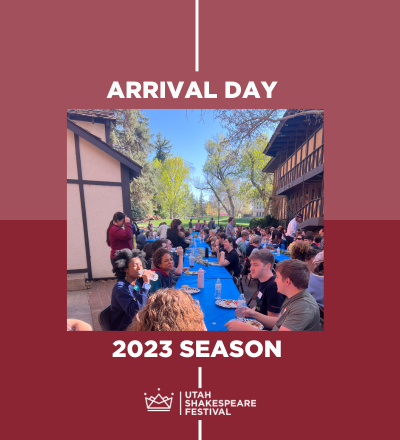
We are thrilled to announce that we welcomed the Festival’s seasonal company last week! Monday, May 8, was arrival day for actors, directors, designers, and artists who checked in, attended group meetings, took tours, and excitedly gathered in preparation for the season to come.
In the Randall L. Jones Theatre for the opening meeting, returning company members embraced one another while also welcoming those here for the first time.
“Welcome to the 62nd season of the Utah Shakespeare Festival,” Interim Managing Director Michael Bahr exclaimed. “We are so thrilled to have you here!”
The number of seasonal artists who come each year and are required to put a season together is extensive and includes directors, designers, stage management, the performing company, voice and speech coaches, music directors/conductors/composers, fight and intimacy directors, choreographers, dramaturgs, hair and makeup artists, props artisans, costume and craft technicians, carpenters, painters, scenic artisans, electrics/sound technicians, guest services, concessionaires, and facilities personnel, among others. These groups of people are in addition to the year-round staff at the Festival.
Following the welcome meeting hosted by Bahr and Interim Artistic Director/Director of New Play Development Derek Charles Livingston, the company wasted no time getting to work–– attending first rehearsals; checking out shops and work spaces; taking measurements for the performing company; and settling in for the magical season ahead.
Publications Manager Marlo Ihler noted that the excitement was palpable during arrival day.
“Meeting the incoming company members in person takes all the work we’ve been doing to prepare for this season to a whole new level,” Ihler said.
Director of Development and Communications Donn Jersey compared the feeling of arrival day to that of a child on Christmas Eve.
“The company arrival day has the same appeal to me . . . the hurried anticipation of all the gifts that will fill me with joy,” Jersey said. “To quote Lin Manuel-Miranda, the plan is to fan this spark into a flame.”
That evening the entire company, year-round staff, families and friends, and special guests were treated to an opening BBQ dinner, hosted by the Guild of the Utah Shakespeare Festival. It was held in the courtyard of the beloved retired Adams Memorial Theatre that the Festival used for decades.
In the first rehearsal for A Midsummer Night’s Dream with Director Jessica Kubzansky, cast, and crew, the director shared what she hoped the play would achieve this season.
“There is so much hate in the world, I thought it was important that we tell a story about how we get to a place of more authentic and inclusive love. This is a story about humanity,” Kubzansky said.
Although Kubzansky was speaking about the play she is directing, this statement can be applied to the Festival’s mission as a whole, as well as the productions this season.
“At the end of the night people are changed and moved . . . and there is joy,” Kubzansky said.
That is exactly the feeling we hope you get when you attend a night (or afternoon) of theater––a kind of rejuvenation, healing, inspiration, and introspection.
We can’t wait to see you when we open June 21, and in the meantime, our entire company and staff will be hard at work in preparation for a magnificent season.
Furthermore, after keeping our doors locked for the safety of our company and staff during the pandemic, we are excited to announce that our administration building is now open during business hours! Our front desk will now be staffed by both volunteers and our Company Management staff. Please visit us in the Festival Administration Building of the Beverley Taylor Sorenson Center for the Arts from 9am to 5pm Monday through Friday.
For more information about the shows or to purchase tickets, call 800-PLAYTIX or visit bard.org/plays.
A Raisin in the Sun: An American Classic
The Utah Shakespeare Festival is excited to announce the cast members for this season’s production of A Raisin in the Sun, including familiar faces to Festival audiences as well as new company members making their first appearance here.
Director Derek Charles Livingston is thrilled to direct this great American classic. This is a much anticipated title, as it has been produced in every major theater in America, and now it is the Festival’s turn. “I think audiences will really enjoy getting to know the Younger family,” says Livingston. A Raisin in the Sun is an example of fine playwriting and great characters, dialogue, and “a lot of plot twists that will keep your heart palpitating,” he said.
The cast is as follows:

Jeffrey Marc Alkins is new to the Festival and is performing the roles of George Murchison and Moving Crew in A Raisin in the Sun and Jonathan in The Play That Goes Wrong. He has worked on Broadway in Mr. Saturday Night and off-broadway as Richard of Gloucester in Richard III at The Flea and Planchet in The Three Musketeers at Classical Theatre Harlem as well as playing the Antipholi in The Comedy of Errors at Shakespeare Theatre NJ, and many more. He is a member of Actors’ Equity Association.

Maureen Azzun is new to the Festival and will appear as Beneatha in A Raisin in the Sun and Cobweb in A Midsummer Night’s Dream. She has performed as Louise/Ruby/Etta in More Than a Maid with Black Ensemble Theater, Friend in Queen C at Trap Door Theatre, and Emerson in First Date on the Brain with Drawing Cats Productions. She was also in the films Erick and Alisha, Rosemary, and Five-Finger Discount.
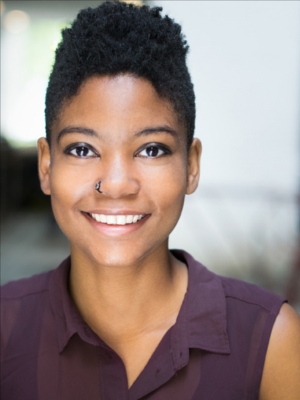
Nazlah Black is making their Festival mainstage debut as Mrs. Johnson in A Raisin in the Sun and Sandra in The Play That Goes Wrong. They toured in the Festival’s 2023 Shakespeare in the Schools production of Othello as Emilia and Bianca. Black played Viola in Twelfth Night at Emit Theatre, Cordelia in King Lear at Barefoot Shakespeare, and Gwendolyn in The Importance of Being Earnest at Encounters Theatre. They also played Rosalind in the film As You Like It, presented by Shakespeare in the Woods.

Topher Embrey is new to the Festival, appearing as Bobo and Moving Crew in A Raisin in the Sun and Bottom in A Midsummer Night’s Dream. Past regional theatre roles include Christmas Present in A Christmas Carol at the Denver Center for the Performing Arts, Sicinius Veletus in Coriolanus at the Colorado Shakespeare Theatre, Sir Toby in Twelfth Night at the Nashville Shakespeare Festival, and Dromio of Ephesus in The Comedy of Errors at the American Shakespeare Center, among numerous others. He is a member of Actors’ Equity Association.
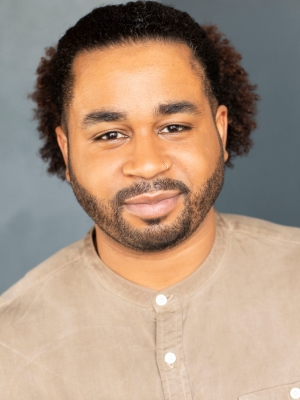
Dylan Fleming is performing the role of Joseph Asagai and Moving Crew in A Raisin in the Sun, Flute in A Midsummer Night’s Dream, and is new to the Festival. He has performed as Omari in Everyman Theatre’s digital release of Pipeline, as Isa in Kill Move Paradise with Rep Stage, and as T.T. Williams in The Member of the Wedding with 1st Stage.

Monique Gaffney will play the role of Lena Younger in A Raisin in the Sun and is new to the Festival. She performed as Monica Coleman in Speaking Truth to Power at Common Ground Theatre, Ashley in The Virgin Trial at Cygnet Theatre, Cynthia in Sweat at San Diego Rep, and many more. She has also appeared on film and television in Tiger Cruise, La Mujer Hambriente, Lincoln Heights, Veronica Mars, and The Chronicle. She is a member of Actors’ Equity Association.
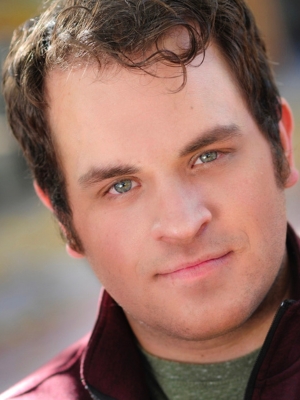
Blake Henri will play the role of Karl Lindner in A Raisin in the Sun and Robert in The Play That Goes Wrong and is new to the Festival. He played The Poet in The Iliad at Oklahoma Shakespeare, Murray in The Odd Couple at WaterTower Theatre, Boddy in Clue at Dallas Theater Center, and much more. Henri has appeared on film and television on Love and Death, American Underdog, Great Plains, and more.
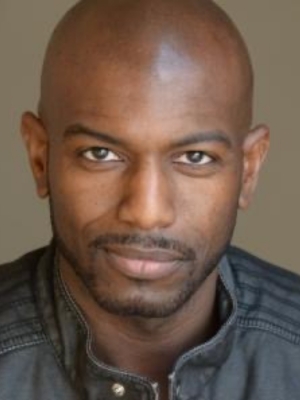
Corey Jones is returning to the Festival and will perform in the roles of Walter Younger in A Raisin in the Sun and Theseus/Oberon in A Midsummer Night’s Dream. He performed at the Festival in 2017 as Tate in How to Fight Loneliness and King John in King John, Caliban in The Tempest in 2013, and Aaron in Titus Andronicos and Rev. Sykes in To Kill a Mockingbird in 2012. Among his many roles, he has played The General in the first and second national Broadway tours of The Book of Mormon, Bruce Laird in the world premiere of A Distinct Society at Pioneer Theater Company, Captain Markinson in A Few Good Men at La Mirada Theatre, Dr. Gibbs in Our Town at South Coast Repertory, and Creon in Oedipus at American Players Theater. He has performed on film and television in Trigger, 11/11/11, Franklin and Bash, A Letter from Birmingham Jail, and Checkout. He is a member of Actors’ Equity Association.
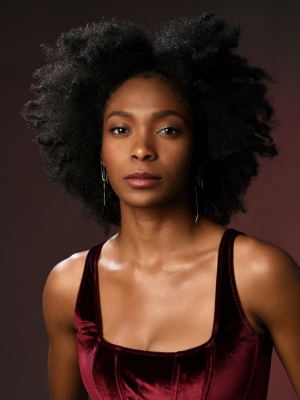
Kayland Jordan is making her Festival debut as Ruth Younger in A Raisin in the Sun and Helena in A Midsummer Night’s Dream. She has been seen as Annabelle “Belle” Pierson in Mirrors at NYTW, Louella in Fancy Maids at Teatro SEA, Lady in Red For Colored Girls…, and Jo in Thorns for African American Museum. She has also performed in numerous films and television shows, including Betty (HBO), In Ice Cold Blood (OXYGEN), Emergence (ABC), and Keep Me At Bay (MICA). She has also been a member of American Fight Directors.


Dylan Nelson and Alyvia Ridgel will be debuting at the Festival as young performers, alternating in the role of Travis Younger in A Raisin in the Sun. Dylan has performed in productions of Willy Wonka Jr., Once On This Island Jr., Dear Edwin Jr., and Once Upon A Mattress Jr. Alyvia is new to acting and is excited to work on this production.
The 2023 season of the Utah Shakespeare Festival runs from June 21 to October 7 and includes Romeo and Juliet, A Midsummer Night’s Dream, Jane Austen’s Emma The Musical, A Raisin in the Sun, The Play That Goes Wrong, Timon of Athens, and Coriolanus, as well as all the experiences surrounding the plays, such as The Greenshow, seminars, orientations, and backstage tours. Tickets and information are available by calling 800-PLAYTIX or visiting bard.org.
The Play That Goes Wrong: A Bit Like a Clown Car
The Utah Shakespeare Festival is thrilled to announce the cast members for this summer’s comedy, The Play That Goes Wrong, which features both new and returning actors.
For those who enjoy hilarious farces, this show is described by director Geoffrey Kent as if “Noises Off drank a case of Red Bull.” It is a play within a play, put on by a group of amateur actors where practically nothing goes as planned and everything falls apart…including the set. It is “one of the more complex shows that the [Festival] has staged in recent memory.” Its scenic elements are “a bit like a clown car”: just when you think there aren’t any more tricks to be seen, it will surprise you over and over!
The cast is as follows:

Jeffrey Marc Alkins is new to the Festival this year and is performing the roles of Jonathan in The Play That Goes Wrong and George and Moving Man in A Raisin in the Sun. He has worked on Broadway in Mr. Saturday Night and off-broadway as Richard of Gloucester in Richard III at The Flea, Planchet in The Three Musketeers at Classical Theatre Harlem, Orderly in Me and the Girls: A Noel Coward Musical at Mary MacArthur, and many more. He is a member of Actors’ Equity Association.

Nazlah Black is making their Festival mainstage debut as Sandra in The Play That Goes Wrong and Mrs. Johnson in A Raisin in the Sun. They toured in the Festival’s 2023 Shakespeare in the Schools production of Othello as Emilia and Bianca. Black played Viola in Twelfth Night for Emit Theatre, Cordelia in King Lear at Barefoot Shakespeare, and Gwendolyn in The Importance of Being Earnest at Encounters Theatre. They also played Rosalind in the film As You Like It, presented by Shakespeare in the Woods.
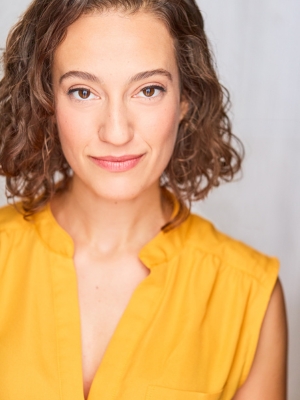
Laura Brennan performed with the Festival’s Shakespeare in the Schools education tour of Much Ado About Nothing in 2022. This season will be her mainstage debut as well, playing Stage Hand in The Play That Goes Wrong and Harriet Smith and Ensemble in Jane Austen’s Emma The Musical. She has also performed with Hoosier Shakespeare Festival, Texas Shakespeare Festival, Cider Mill Playhouse, and First Folio Theatre, among many others.
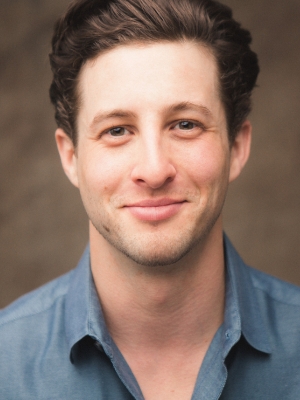
Rhett Guter returns to the Festival, playing Chris in The Play That Goes Wrong and Mr. George Knightley in Jane Austen’s Emma The Musical this season. He has performed in over twenty Festival productions between 2005 and 2021, including Ragtime, The Pirates of Penzance, Peter and the Starcatcher, The Music Man, and The Greenshow. He is also a magician and prolific choreographer, having choreographed numerous productions here. He is a member of Actors’ Equity Association.

Blake Henri will play the role of Robert in The Play That Goes Wrong and Karl Lindner in A Raisin in the Sun and is new to the Festival. He played The Poet in The Iliad at Oklahoma Shakespeare, Murray in The Odd Couple at WaterTower Theatre, Boddy in Clue at Dallas Theater Center, and much more. Henri has appeared in film and television on Love and Death, American Underdog, Great Plains, and more.

Chris Mixon returns for his eleventh season at the Festival since 2002. This time he will be playing Dennis in The Play That Goes Wrong and Mr. Woodhouse and Ensemble in Jane Austen’s Emma The Musical. His theatre work includes the national Broadway tour of How to Succeed in Business Without Trying, world and NYC premieres at Pearl Theatre Company, and productions at Milwaukee Repertory Theatre, Pioneer Theatre Company, Geva Theatre, Orlando Shakespeare Theatre, and Alabama Shakespeare Theatre, among many others. He also has film and television credits including The Rosa Parks Story (CBS), All My Children (ABC), One Life to Live (ABC), and Law & Order (Wolf Films/Universal TV). He is a member of Actors’ Equity Association.
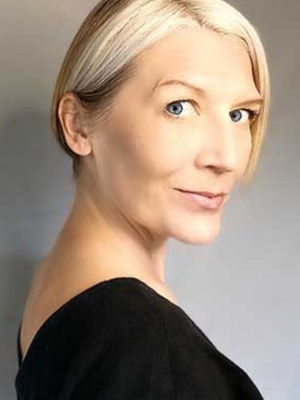
Melinda Parrett returns as Annie in The Play That Goes Wrong and Miss Bates and Ensemble in Jane Austen’s Emma The Musical. She has performed in nearly twenty productions at the Festival since 2007, including as Mrs. White in Clue, Elsa Schraeder in The Sound of Music, Titania and Hippolyta in A Midsummer Night’s Dream, Adelaide in Guys and Dolls, and Reno Sweeney in Anything Goes. Other theatres she has worked at include Denver Center, Goodspeed Opera House, Geva Theatre, Santa Cruz Shakespeare, and Oregon Cabaret Theatre. She is a member of Actors’ Equity Association.
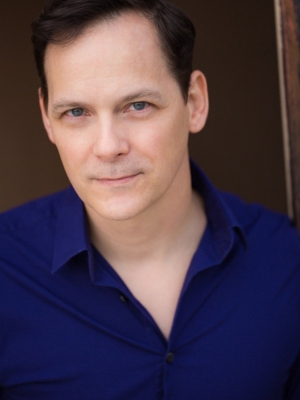
Jim Poulos returns for his fourth season at the Festival, having previously played Ross in Macbeth, Henry VI and Ensemble in Henry VI Part One and The Conclusion of Henry VI: Parts Two and Three, and The Duke and Ensemble in Big River. This season he will perform as Max in The Play That Goes Wrong and Mr. Elton and Ensemble in Jane Austen’s Emma The Musical. Other theatres include American Repertory Theatre, Repertory Theatre of St. Louis, Geva Theatre, Denver Center, and Great River Shakespeare Festival, among others. He is a member of Actors’ Equity Association.
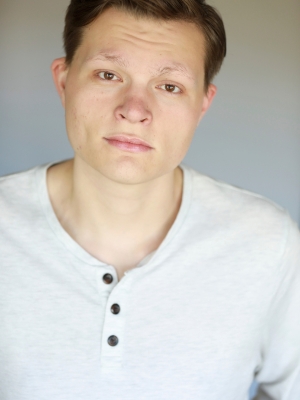
Cameron Vargas is new to the Festival and will perform the roles of Trevor in The Play That Goes Wrong and Robert Martin and Ensemble in Jane Austen’s Emma The Musical. He has also acted in Dogfight at Sierra Repertory Theatre, West Side Story and Little Women at Granbury Theatre Company, Indivisible With… and Julius Caesar at Milwaukee Rep Project, and several others at PCPA.
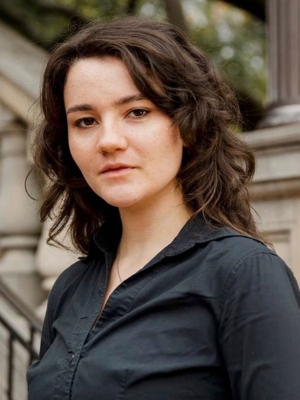
Grace Wissink is also new to audiences at the Festival. This season she will perform as Stage Hand in The Play That Goes Wrong and Elizabeth Martin and Ensemble in Jane Austen’s Emma The Musical. Previous experience includes Hamlet at Playmakers Repertory Company, Nia and Dance Nation at Kenan Theatre Company, Fun Home at Company Carolina, and The Birthday Party at LAB! Theatre.
The 2023 season of the Utah Shakespeare Festival runs from June 21 to October 7 and includes Romeo and Juliet, A Midsummer Night’s Dream, Jane Austen’s Emma The Musical, A Raisin in the Sun, The Play That Goes Wrong, Timon of Athens, and Coriolanus, as well as all the experiences surrounding the plays, such as The Greenshow, seminars, orientations, and backstage tours. Tickets and information are available by calling 800-PLAYTIX or visiting bard.org.
Festival Throws 22nd Annual Bard's Birthday Bash

The Festival celebrated William Shakespeare’s 459th birthday in April with a three-day bash! The Bard is regarded as one of the greatest writers in the English language, as well as one of its most revered and studied dramatists, and we love involving the community––and especially students––when we celebrate him. The Bard’s Birthday Bash took place on April 19-21 this year.
Since the Festival was founded in 1961 by the late Fred C. Adams, we have celebrated the genius, magic, brilliance, and importance of Shakespeare’s works and continue to recognize him as the cornerstone of our mission.
“It’s a way to celebrate Shakespeare and theatrical performance, and to get a taste of theatre, dance, and youthful energy and optimism,” Interim Managing Director Michael Bahr said.
The 22nd annual event targets local elementary school students, in order to build excitement and connection to Shakespeare at a young age. Community members were also welcome to attend.
The celebration took place on the grounds of Southern Utah University and consisted of jousting, dancing the Maypole, performances in the Adams Memorial Theatre, theatre games, and birthday cake with Queen Elizabeth. This year, the bash was even more special––an extra day was added to the schedule to make room to celebrate with even more students, teachers, and community members.
“Celebrating The Bard with young people is one of the highlights of the year. These students come with such enthusiasm and joy, while participating in both performative and physical activities,” Associate Education Director Stewart Shelley said.
“As the 2023 school year comes to a close, it is wonderful to see students out-of-doors, laughing, playing, and enjoying this birthday celebration together,” Shelley added.
A cadre of volunteers from the Festival’s education department, Guild of the Utah Shakespeare Festival, and SUU Play Team members ran the event.
“Students rotated through the different activities and shared in the celebratory festivities,” Shelley explained. “Many schools were able to perform a brief piece of Shakespeare’s literature with us on the Adams stage, and others who didn’t bring a piece had the opportunity to learn and perform some lines while here.”
To register for next year’s Birthday Bash, email usfeducation@bard.org with the name of the school, the teachers, contact information, and the approximate number of students. For information about the Festival’s upcoming season and to purchase tickets, visit bard.org or call 1-800-PLAYTIX.
Othello and Every Brilliant Thing Tours Come to a Close
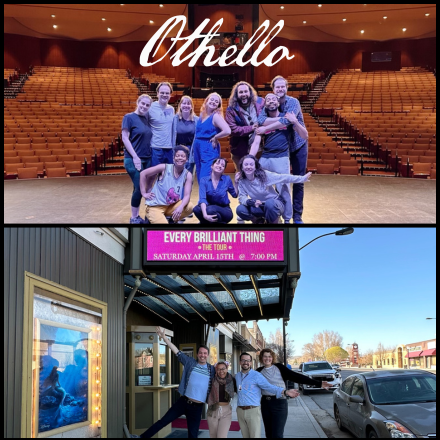
The Festival has been in the midst of two touring productions since January of this year–– Othello and Every Brilliant Thing––and these productions recently came to a close.
“We are so pleased to report that both the Shakespeare in the Schools and Every Brilliant Thing tours returned home safely to Cedar City on Saturday, the 22nd of April,” Associate Education Director Stewart Shelley said.
Othello, directed by Cordell Cole, toured for the Shakespeare in the Schools education program which was funded by the National Endowment for the Arts/Arts Midwest, Utah State Office of Education, and Ally Bank, and Every Brilliant Thing was funded by the Utah State Legislature. While the audiences were similar, the goals for each show were different.
Othello was designed for audiences to have a condensed yet complete theatrical experience, with lights, costume, and sound design. Every Brilliant Thing was a much smaller production with only one actor that aimed to reach students with important messages about mental health and hope.
Othello
Shakespeare in the Schools is a program that “brings quality Shakespeare performances and workshops to schools and communities throughout the West,” and has been doing so for twenty-nine years. This year was no exception. This time the touring company performed for nearly 10,000 students and 600 teachers and staff.
Since January 30, a team of ten members traveled across Arizona, Idaho, Nevada, and Utah to bring timely messages of the dangers of jealousy, racism, and manipulation found in Othello to primarily middle and high school students. The team consisted of Tour Manager Abby Nakken, Stage Manager Lindy Rublaitus, Technical Director April Salazar, and actors Nazlah Black, Darin Earl II, Ian Geers, Rachel J. Jones, Shay Jowers, Noah Ratgen, and Nic Sanchez.
View photos from the Othello tour here.
Every Brilliant Thing
Filled with humor and inventiveness, the plot explored hope and depression, change and uncertainty, relationships and risk, guilt and forgiveness.
Also directed by Cordell Cole, the traveling company consisted of just four members: Tour Manager Jordan Simmons, Stage Manager Kathryn Whilden, and actors Kat Lee and Jeremy Thompson, who took turns playing the role.
Beginning February 13, the tour traveled to numerous schools and communities in Utah. The production was free to any school in Utah that was interested and was performed for almost 2,000 students and 500 adults.
View photos from the Every Brilliant Thing tour here.
On the Road
The touring season presented challenges, such as record snowfall and incredibly emotional shows that required a lot from the teams. But the company members of the two tours were pleased to reach so many people.
“We had incredible responses from our audiences with thought provoking and exciting questions during our talkbacks after the shows,” Shelley said. “We are sad to see our team depart, but incredibly proud of the work they have done over the past four months.”
2024 Tours
Although the tours recently had their last performances this year, touring will continue in the spring of 2024.
The title for next year’s Shakespeare in the Schools was recently announced by the Festival’s education staff.
“2024 will be the 30th Anniversary of the Festival’s Shakespeare in the Schools program! To mark this milestone, we are thrilled to be presenting Shakespeare’s incomparable Hamlet for schools across the region,” Education Director Katherine Norman said.
“In addition to our immense gratitude for the work of these two tours, we are also excitedly looking forward to next year! 2024 will be the third iteration of Every Brilliant Thing throughout the state of Utah,” Norman said. “We are thrilled to be able to bring this hopeful and life-saving message to even more students.”
For more information about next year’s educational touring productions, please reach out to the Festival’s education department at usfeducation@bard.org.
5th Annual Make A Scene Fundraiser a Successful, Fun Event
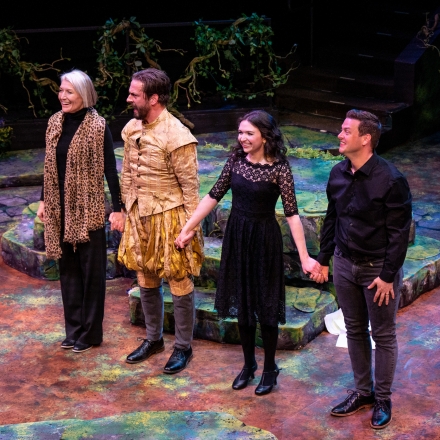
The Utah Shakespeare Festival hosted the fifth annual Make A Scene fundraising event on April 19 at the West Valley City Performing Arts Center in northern Utah. The one-night-only gala featured dinner and a comedic performance of Romeo and Juliet, directed by Festival actor Quinn Mattfeld.
Additional Festival actors Michael Doherty, Melinda Parrett, and Rhett Guter brought laughter and magic––literally––to the night, with Mattfeld, Doherty, and Parrett onstage, and Guter performing magic tricks throughout the evening.
Utah State University actress Mia Gatherum also hit the stage, and with Mattfeld, the duo played Juliet and Romeo.
“Quinn, my team, and I knew that an evening of laughter, food, and fun would be the perfect kick-off to the upcoming 2023 season,” said Director of Development and Communications Donn Jersey. “We really had a great time putting it all together.”
Development Associate Emily Cacho noted that the event was filled with friends and supporters, both old and new.
“We had a fantastic turnout, with around 200 people in attendance,” Cacho said. “We had many new fans of the Utah Shakespeare Festival in attendance as well as many tried-and-true patrons of our organization. Overall I would say we had a very successful event!”
Additionally, over $60,000 was raised at the event to support the Festival’s endeavors.
“There were many special guests in attendance, including Utah state legislatures and civic leaders, as well as our friends from Pathway and Associates,” Cacho said.
Interim Artistic Director/Director of New Play Development Derek Charles Livingston seconded Cacho’s remarks, calling the event a “terrific and fun-filled evening.”
He also expressed his gratitude to the supporters and performers who made the evening possible.
“We are so fortunate to have such wonderful supporters who will ‘play’ along with us, and such a great family of actors to make a whole evening come alive,” Livingston said.
Ultimately, the evening represented what the Festival stands for: “This whole event was an example of what makes the Festival a special organization – the spirit, the storytelling, the camaraderie, the magic.”
Jane Austen’s Emma The Musical: A Heartfelt Celebration
The Utah Shakespeare Festival is excited to announce the cast members for this summer’s production of Jane Austen’s Emma The Musical, including familiar faces to Festival audiences as well as new company members making their first appearance here.
As an ardent Jane Austen fan, director Valerie Rachelle says she is thrilled to bring this story to the stage, and especially as a musical because Austen’s characters are so “comedic, loving, laughable, and heartfelt”. She compares the show to champagne, as she hopes audiences will enjoy the sparkle, celebration, elegance, joy, and humor, all based on Jane Austen’s beloved novel. This is a perfect production for the whole family to enjoy
The lead cast is as follows:
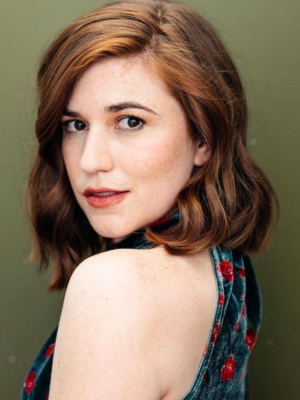
Allie Babich returns to the Festival after eight years. This season she plays Emma Woodhouse in Jane Austen’s Emma The Musical and Balthasar in Romeo and Juliet. Festival audiences may remember her as Ensign Nellie Forbush in South Pacific, Ela Delahay in Charley’s Aunt, and Vixen/Ensemble in Dracula. She has also performed with First Stage, Milwaukee Opera Theatre, American Shakespeare Center, Door Shakespeare, Guthrie Theatre, and in an international Disney on Classic: A Magical Night Tour to Japan. She is a member of Actors’ Equity Association.

Laura Brennan performed with the Festival’s Shakespeare in the Schools education tour of Much Ado About Nothing in 2022. This season will be her mainstage debut, playing Harriet Smith/Ensemble in Jane Austen’s Emma The Musical and Stage Hand in The Play That Goes Wrong. She has also performed with Hoosier Shakespeare Festival, Texas Shakespeare Festival, Cider Mill Playhouse, and First Folio Theatre, among many others.

Rhett Guter returns to the Festival, playing Mr. George Knightley in Jane Austen’s Emma The Musical and Chris in The Play That Goes Wrong this season. He has performed in over twenty Festival productions between 2005 and 2021, including Ragtime, The Pirates of Penzance, Peter and the Starcatcher, The Music Man, and The Greenshow. He is also a magician and prolific choreographer, having choreographed numerous productions here. He is a member of Actors’ Equity Association.

Chris Mixon returns for his eleventh season at the Festival since 2002. This time he will be playing Mr. Woodhouse/Ensemble in Jane Austen’s Emma The Musical and Dennis in The Play That Goes Wrong. His theatre work included the national Broadway tour of How to Succeed in Business Without Trying, world and NYC premieres at Pearl Theatre Company, and productions at Milwaukee Repertory Theatre, Pioneer Theatre Company, Geva Theatre, Orlando Shakespeare Theatre, and Orlando Shakespeare Theatre, among many others. He also has film and television credits including The Rosa Parks Story (CBS), All My Children (ABC), One Life to Live (ABC), and Law & Order (Wolf Films/Universal TV). He is a member of Actors’ Equity Association.
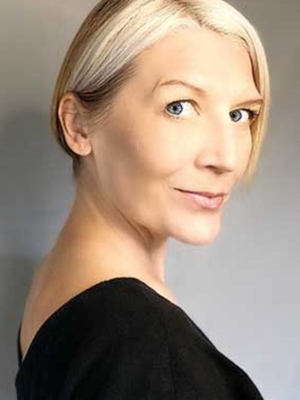
Melinda Parrett returns as Miss Bates/Ensemble in Jane Austen’s Emma The Musical and Annie in The Play That Goes Wrong. She has performed in nearly twenty productions at the Festival since 2007, including as Mrs. White in Clue, Elsa Schraeder in The Sound of Music, Titania/Hippolyta in A Midsummer Night’s Dream, Adelaide in Guys and Dolls, and Reno Sweeney in Anything Goes. Other theatres she has worked at include Denver Center, Goodspeed Opera House, Geva Theatre, Santa Cruz Shakespeare, and Oregon Cabaret Theatre. She is a member of Actors’ Equity Association.

Jim Poulos returns for his fourth season at the Festival, having previously played Ross in Macbeth, Henry VI/Ensemble in Henry VI Part One and The Conclusion of Henry VI: Parts Two and Three, and The Duke/Ensemble in Big River. This season he will perform as Mr. Elton/Ensemble in Jane Austen’s Emma The Musical and Max in The Play That Goes Wrong. Other theatres include American Repertory Theatre, Repertory Theatre of St. Louis, Geva Theatre, Denver Center, and Great River Shakespeare Festival, among others. He is a member of Actors’ Equity Association.
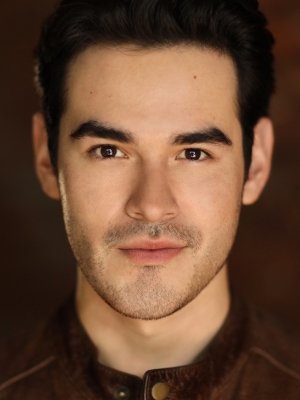
Gilberto Saenz performed with the Festival’s Shakespeare in the Schools education virtual tour of Julius Caesar in 2021 and makes his mainstage debut this season as Mr. Frank Churchill/Ensemble in Jane Austen’s Emma The Musical and Tybalt in Romeo and Juliet. He has also performed with AhHa Broadway as Ernst Robel in Spring Awakening, The Tank NYC as Avery the Amazing in Amazing, and Milwaukee Rep as Indio in West Side Story. He has also appeared in the films Voyeur and Untitled Tenderness Project.
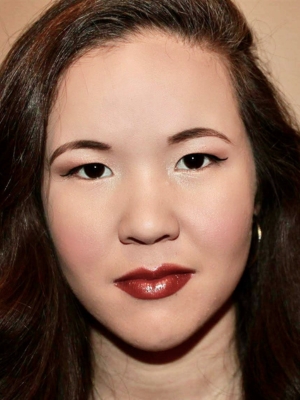
Marissa Swanner is new to the Festival and will play Mrs. Elton/Ensemble in Jane Austen’s Emma The Musical and is a Featured Performer in The Greenshow. Previous experience includes directing and choreographing Tick, Tick… BOOM! at Lyrique Music Productions, The King and I with Drury Lane Theatre, South Pacific and All Shook Up at Flat Rock Playhouse, Breakfast at Tiffany’s at Dinah Washington Center, and The Marvelous Mrs. Maisel on Amazon Prime.
Additional members of the cast are:
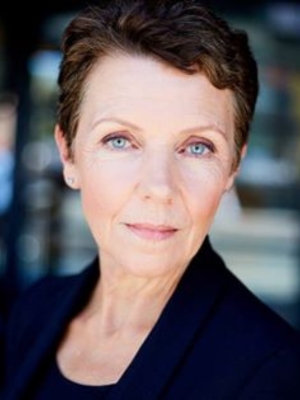
Evelyn Carol Case makes her Festival debut as Mrs. Bates/Ensemble in Jane Austen’s Emma The Musical and Prince Escalus in Romeo and Juliet. She has appeared with Prague Shakespeare Company, Shakespeare Orange County, Steppenwolf Theatre Company, The Laguna Playhouse, and ten seasons as a resident artist with the Alabama Shakespeare Festival.
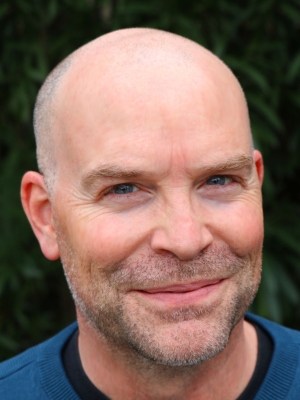
Tim Fullerton is returning to the Festival after appearing as Judge in last season’s Sweeney Todd and Cornwall in King Lear. Audiences can see him this season as Mr. Weston/Ensemble in Jane Austen’s Emma The Musical and Capulet in Romeo and Juliet. Productions with other theatre companies include Poirot: Murder on the Links with Oregon Cabaret Theatre, The Book of Will with Texas Shakespeare, Mamma Mia! with Pacific Conservatory Theatre, and he was part of the original cast recording of The Three Musketeers with American Musical Theatre.

Kat Lee returns to the Festival, coming directly from this year’s Every Brilliant Thing Utah touring production. This season she will play Mrs. Weston/Ensemble in Jane Austen’s Emma The Musical and Lady Montague/Paris page in Romeo and Juliet. Additional roles with the Festival include two seasons as a Featured Performer in the The Greenshow, Harlem Woman in Ragtime, and Angel-ett/Ensemble in Joseph and the Amazing Technicolor Dreamcoat, among others. She has also performed at the Denver Center, Short North Stage, and Lyric Repertory Theatre.

Cameron Vargas is new to the Festival and will perform the roles of Robert Martin/Ensemble in Jane Austen’s Emma The Musical and Trevor in The Play That Goes Wrong. He has also acted in Dogfight at Sierra Repertory Theatre, West Side Story and Little Women at Granbury Theatre Company, Indivisible With… and Julius Caesar at Milwaukee Rep Project, and several others at PCPA.

Grace Wissink is also new to audiences at the Festival. This season she will perform as Elizabeth Martin/Ensemble in Jane Austen’s Emma The Musical and Stage Hand in The Play That Goes Wrong. Previous experience includes Hamlet at Playmakers Repertory Company, Nia and Dance Nation at Kenan Theatre Company, Fun Home at Company Carolina, and The Birthday Party at LAB! Theatre.
The 2023 season of the Utah Shakespeare Festival runs from June 21 to October 7 and includes Romeo and Juliet, A Midsummer Night’s Dream, Jane Austen’s Emma The Musical, A Raisin in the Sun, The Play That Goes Wrong, Timon of Athens, and Coriolanus, as well as all the experiences surrounding the plays, such as The Greenshow, seminars, orientations, and backstage tours. Tickets and information are available by calling 800-PLAYTIX or visiting bard.org.
10 Fascinating Facts about Jane Austen's Emma The Musical
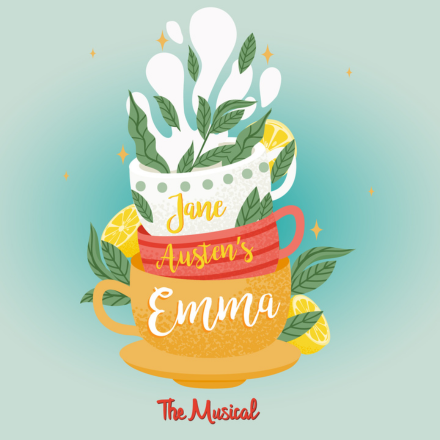
This novel-to-play adaptation is based off of the popular book by Jane Austen and is known for its “handsome, clever, and rich” heroine, as its famous first-line describes. The Festival’s production, directed by Valerie Rachelle, promises to be sweet, intelligent, and buoyant, fun for the whole family, and is one not to be missed!
About Jane Austen’s Novel
- Unlike Austen’s other beloved female characters faced with the dilemma of marrying for status, Emma is not concerned about marriage. Instead, she is worried about boredom! Although this received criticism at the time, this is something many readers now love most about Emma.
- Elizabeth Bennet, from Austen’s novel Pride and Prejudice, was seen as “a delightful creature.” The author set out to create Emma as a main character that “whom no one but myself would much like.” However, it turned out the realism and lack of perfection that Austen illustrated in the supposedly unlikeable heroine became one of her most popular characters.
- Austen is known profoundly for her strong female characters and bold writing. The Guardian wrote “Female self-worth could have been invented by Jane Austen; no wonder we still value her.” However, this didn’t make the author immune to her own insecurity, and it is said that she had anxiety over how Emma would be received by the public. “My greatest anxiety at present, is that this fourth work should not disgrace what was good in the others. . . I am strongly haunted by the idea that to those readers who preferred Pride and Prejudice it will appear inferior in wit, and to those who have preferred Mansfield Park*, very inferior in a good sense.”*
- Austen needn’t have worried, as Emma has garnered praise both now and during its time. The Prince Regent loved Austen’s novels so much that his librarian pushed her to dedicate a work to him. You can find this dedication to him at the beginning of Emma: “To His Royal Highness the Prince Regent, this work is, by His Royal Highness’s permission, most respectfully dedicated to His Royal Highness by His dutiful and obedient humble servant, the Author.”
- The author called Lord Byron’s publisher a “rogue” and chose to pay for advertising and its initial print of the novel herself.
Jane Austen and Music
- Austen would have been thrilled with this musical adaptation, as she played the piano herself from the age of ten. Along with manuscripts, her family inherited some of her sheet music.
- Judging by the music from her collection, it’s speculated that Austen would have been a soprano and would accompany herself on the piano.
- Austen illustrated her love of music by portraying many of her female characters as musicians as well. Some of these characters include Marianne in Sense and Sensibility, Catherine Morland in Northanger Abbey, and Elizabeth and Mary Bennet in Pride and Prejudice.
The Musical
- The musical was compared to candy, with Talkin’ Broadway saying Emma is “a bonbon to satisfy the sweet tooth of theater-goers.”
- The famous American musician, composer, and producer Paul Gordon wrote the music. He was a keyboardist and guitarist in the bands The B-52’s and New Radicals. Gordon also worked with clients such as Prince, Natasha Bedingfield, Lisa Maria Presley, and the Goo Goo Dolls.
To purchase tickets to Jane Austen’s Emma The Musical, visit bard.org or call 800-PLAYTIX. The play previews June 22 at 2 p.m. and opens July 1 at 2 p.m. in the Randall L. Jones Theatre, and plays through October 7.




